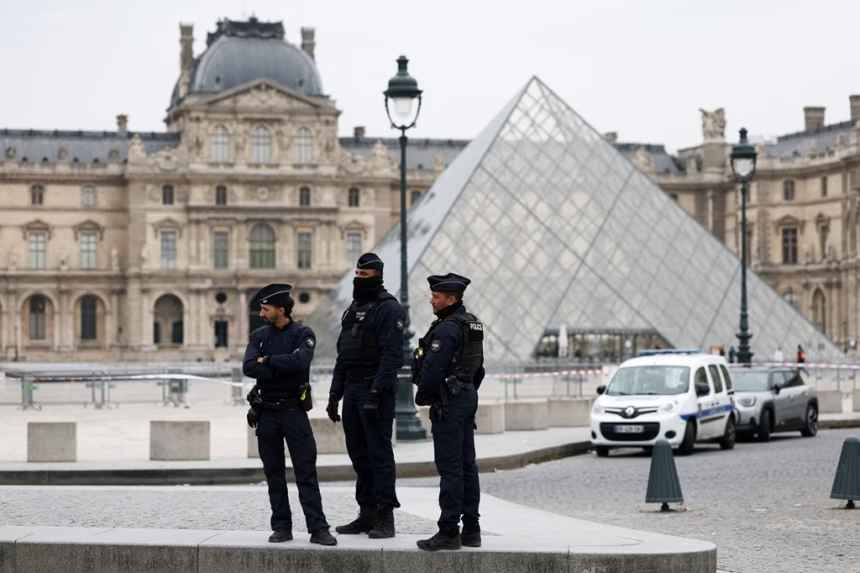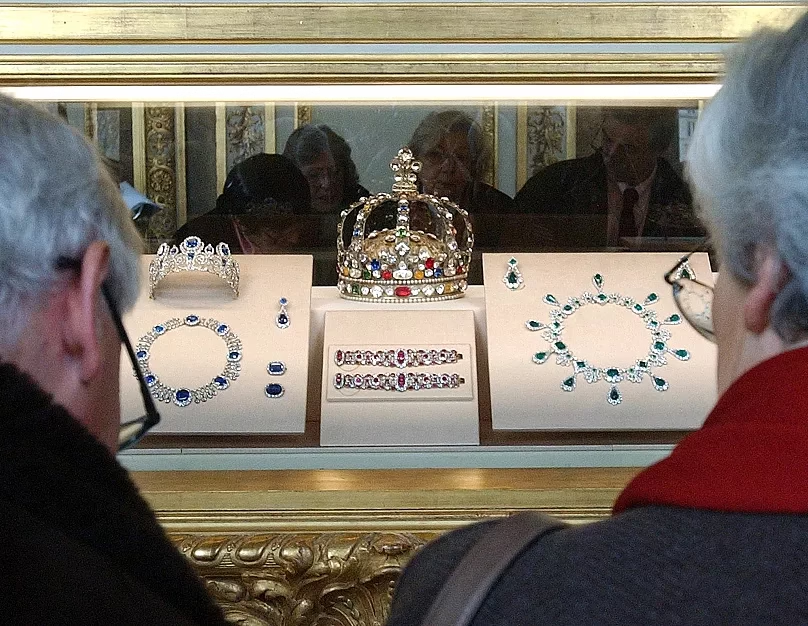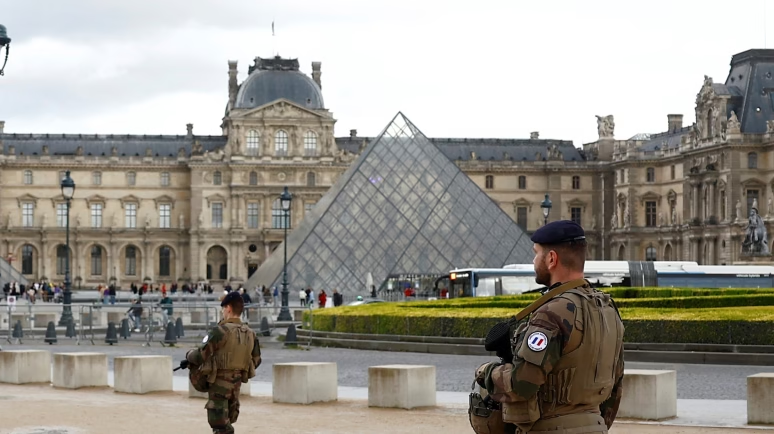PARIS, France – Masked thieves raided the Louvre Museum on Sunday morning, 19 October 2025, escaping with eight treasures of 19th-century jewellery in a lightning-fast strike that lasted only seven minutes. The theft, carried out just as the museum opened to visitors, sent shock through Paris and beyond.
President Emmanuel Macron condemned the act as “an attack on a heritage that we cherish because it is our History,” and promised swift action to recover the works. The Louvre, the most visited museum on the planet with 8.7 million visitors in 2024, closed for the day. Thousands of tourists stood bewildered around the glass pyramid while soldiers and police secured the site.
The robbery began around 9:30 a.m., moments after opening, turning a regular Sunday into sudden turmoil. Witnesses described sirens, alarms and urgent evacuations as staff led people out of the building. “One minute I was lining up for the Mona Lisa, the next we were being pushed outside like a fire drill gone wrong,” said Joan Carpenter, 52, from New York. “You could feel the tension, this is the Louvre.”
The louvre Robbery
Investigators believe four thieves, masked and dressed in dark clothing, used ongoing construction on the riverside wing to gain an advantage. They arrived on motorbikes for a quick getaway and reversed a stolen lorry, fitted with a hydraulic basket lift, against the second-floor façade on the Seine side.
Using angle grinders, they cut through reinforced windows in seconds, then climbed into the Galerie d’Apollon. This gilded hall, painstakingly restored and reopened in 2020, displays France’s royal regalia, including the famed Regent and Sancy diamonds. Those stones, thankfully, were not touched.
Inside, the thieves used power tools to attack display cases, focusing on Napoleon-era jewels with cold precision. They smashed the glass and swept up pieces linked to emperors and empresses who once dazzled European courts.
The stolen haul included emerald necklaces and earrings from Marie-Louise’s trousseau, sapphire sets worn by Queens Hortense and Marie-Amélie, and ornate diadems and brooches made for Empress Eugénie, wife of Napoleon III.
In the rush to flee, two items were dropped, among them Eugénie’s diamond and emerald crown. It was recovered outside with damage, a stark coda to a frantic exit.
Culture Minister Rachida Dati, who arrived at the scene, said the thieves spent about four minutes inside the gallery, and described the operation as highly professional. “These were no amateurs,” she told TF1. “Organised crime is targeting our museums, this was planned in detail.”
The gang fled on motorbikes and left the lorry behind after a failed attempt to burn it, stopped by a fast-acting guard with a fire extinguisher. No one was hurt, though staff and visitors were badly shaken. Unions renewed warnings about long-term staffing gaps and crowding that have dogged the Louvre.
Manhunt after Louvre Museum Robbery
By Monday, forensic teams in white suits were combing the shattered room for fingerprints and DNA. Paris prosecutors opened an investigation into aggravated theft by an organized gang and criminal conspiracy. Interior Minister Laurent Nuñez called it “a major, highly organised operation,” and deployed units from the Brigade de Recherche et d’Intervention (BRI), along with Interpol art-crime specialists.
Detectives are reviewing footage from more than a thousand cameras across the museum. Road checks and airport alerts are in place, and investigators are tracking possible fences in Europe and beyond. Paris Prosecutor Laure Beccuau told BFM TV that the jewels form part of inalienable French heritage and cannot surface on the legal market without detection, which points to black-market laundering and possible links to drug networks.
Art-crime experts warn that while culturally priceless, the pieces could be broken up and sold for their stones, a bleak end for symbols of imperial France. Dutch investigator Arthur Brand, who has helped recover high-profile stolen works, said history shows most thieves make mistakes. He voiced confidence that the pieces can be found and the culprits caught.
Security at the Louvre had already been under review, with plans announced in January to strengthen systems and procedures. Those promises now face urgent scrutiny. Dati has ordered an immediate audit, and officials are grappling with reports of budget pressure and the strain of ever-growing attendance.
The theft follows a series of museum raids across France. In recent months, robbers used blowtorches to take €600,000 in raw gold from the Natural History Museum, and thieves stole €9.5 million worth of porcelain in Limoges. Far-right leader Jordan Bardella called the Louvre heist “an unbearable humiliation,” stoking a wider debate on national pride and cultural protection.
Louvre Thefts and Near-Misses
This latest crime reopens a long history of audacious thefts at the Louvre, a museum born in 1793 out of revolutionary upheaval. From fortress to palace to national museum, it was meant to protect art for the public. Yet determined thieves have found ways in before.
The most famous case remains the 1911 theft of Leonardo da Vinci’s Mona Lisa. Vincenzo Peruggia, an Italian glazier and Louvre employee, hid overnight, slipped the small panel under his clothes and walked out. The painting vanished for two years and turned into a worldwide sensation. It was recovered in 1913 and later placed behind bulletproof glass after vandalism in the 1950s.
During the Second World War, director Jacques Jaujard oversaw the evacuation of thousands of masterpieces to chateaux and rural hideouts. Even with that effort, Nazi looters still seized artworks, including pieces by Botticelli and Rubens. Postwar returns brought many home, though restitution claims continue to this day.
The postwar decades saw sporadic thefts. In 1971, Gustave Courbet’s stormy seascape The Wave disappeared, likely lifted by professionals who dodged alarms. In 1976, masked thieves scaled scaffolding, much like Sunday’s crew, to snatch King Charles X’s diamond-studded sword through a second-floor window. In 1983, Renaissance armour, including a Milanese helmet and breastplate from the Rothschild collection, was stolen, then resurfaced decades later and was recovered in 2021 at a military sale in Bordeaux.
Other incidents chipped away at confidence. A delicate still life by Jean-Baptiste-Siméon Chardin vanished under murky circumstances late in the 20th century. In 1998, a thief pulled Jean-Baptiste-Camille Corot’s Le Chemin de Sèvres off the wall during opening hours. Security changes followed, though not enough to stop the latest raid. Historian Aaron Freundschuh, writing in Urban History in 2006, described the ongoing tension between keeping museums open and keeping them secure.
This new blow, in the shadow of the Eiffel Tower, makes a hard point. Even the most guarded institutions are not immune. Paris woke to tighter checks, closed doors and plenty of speculation. Some wonder if insiders helped; others see the hand of organized crime. What is certain is the strength of the public bond with the Louvre’s collections. As Macron vowed, “We will recover the works.” The search is underway, and France is watching.

















